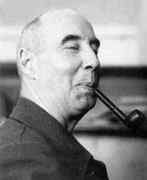◀ ▲ ▶History / 20th-century / Person: Stueckelberg, Ernst Carl Gerlach
Person: Stueckelberg, Ernst Carl Gerlach

Ernst Carl Gerlach Stueckelberg was a Swiss mathematician and physicist. Although he made important advances never received the recognition for his achievements which many felt that he clearly deserved.
Mathematical Profile (Excerpt):
- He was baptised Johann Melchior Ernst Karl Gerlach Stückelberg but in later life he gave his name as Ernst Carl Gerlach Stückelberg.
- A chapel to commemorate this stood from the 14th century but in 1879-80 a new chapel was built (which still stands) and decorated with four marvellous frescos showing scenes of Tell's life painted by Ernst Stückelberg.
- Then Ernst Stueckelberg's full name became Johann Melchior Ernst Karl Gerlach Stückelberg von Breidenbach zu Breidenstein und Melsbach.
- Stueckelberg was brought up and educated in Basel where he attended the Humanistic Gymnasium, a 16th century secondary school in the Cathedral Square of Basel.
- In 1930, only a few years after Stueckelberg graduated from the school, it changed its name to Gymnasium am Münsterplatz.
- Stueckelberg worked in the Institute which had been set up for Sommerfeld, with rooms for seminars, rooms for assistants, and laboratories for experimental work.
- It was only after completing his doctoral thesis that Stueckelberg moved from experimental physics to theoretical physics.
- Philip Morse met Stueckelberg at this time.
- His full name was Ernst Carl Gerlach Melchior Stueckelberg von Breidenbach zu Breidenstein.
- These casual lectures started both Ernst and me off in new research directions.
- In 1930 Stueckelberg was appointed as a research associate and assistant professor at Princeton.
- There Stueckelberg and Morse worked together on high energy collisions.
- In the spring Stueckelberg, together with Morse, moved to England to spend time at Cambridge.
- Stueckelberg submitted his habilitation thesis to the University of Zürich and gained the right to become a lecturer.
- In September 1934 Stueckelberg submitted the paper Relativistisch invariante Störungstheorie des Diracschen Elektrons Ⓣ(The relativistically invariant perturbation theory of the direct electron) to Annalen der Physik.
- Stueckelberg was appointed to succeed him in the following year.
- The "modernity" of this contribution is striking and characteristic of Stueckelberg's original turn of mind.
- He then quoted Stueckelberg's 1934 paper as giving an example of such a covariant theory.
- This was not Stueckelberg's only contribution to the renormalization programme, however, for in the early 1940s he wrote a long paper outlining a complete and correct description of the renormalization procedure for quantum electrodynamics.
- He then set about filling in all the details but Schwinger and Feynman published their version first and Stueckelberg received no recognition for his remarkable contributions.
- After receiving the Nobel Prize, Feynman lectured at CERN to an audience which included Stueckelberg.
- Stueckelberg continued to hold the chair at Geneva until he retired in 1975.
- Although the problems continued to recur, Stueckelberg was able to carry out his duties.
- Although Stueckelberg never received the recognition for his achievement which many felt that he so clearly deserved, he did receive a number of significant honours.
Born 1 February 1905, Basel, Switzerland. Died 4 September 1984, Geneva, Switzerland.
View full biography at MacTutor
Tags relevant for this person:
Origin Switzerland
Thank you to the contributors under CC BY-SA 4.0! 

- Github:
-

- non-Github:
- @J-J-O'Connor
- @E-F-Robertson
References
Adapted from other CC BY-SA 4.0 Sources:
- O’Connor, John J; Robertson, Edmund F: MacTutor History of Mathematics Archive
